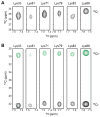Effective strategy to assign ¹H- ¹⁵N heteronuclear correlation NMR signals from lysine side-chain NH3₃⁺ groups of proteins at low temperature
- PMID: 25129623
- PMCID: PMC4160661
- DOI: 10.1007/s10858-014-9854-y
Effective strategy to assign ¹H- ¹⁵N heteronuclear correlation NMR signals from lysine side-chain NH3₃⁺ groups of proteins at low temperature
Abstract
Recent studies have shown that lysine side-chain NH3(+) groups are excellent probes for NMR investigations of dynamics involving hydrogen bonds and ion pairs relevant to protein function. However, due to rapid hydrogen exchange, observation of (1)H-(15)N NMR cross peaks from lysine NH3(+) groups often requires use of a relatively low temperature, which renders difficulty in resonance assignment. Here we present an effective strategy to assign (1)H and (15)N resonances of NH3(+) groups at low temperatures. This strategy involves two new (1)H/(13)C/(15)N triple-resonance experiments for lysine side chains. Application to a protein-DNA complex is demonstrated.
Figures




Similar articles
-
A Unique and Simple Approach to Improve Sensitivity in 15N-NMR Relaxation Measurements for NH₃⁺ Groups: Application to a Protein-DNA Complex.Molecules. 2017 Aug 15;22(8):1355. doi: 10.3390/molecules22081355. Molecules. 2017. PMID: 28809801 Free PMC article.
-
Heteronuclear NMR spectroscopy for lysine NH(3) groups in proteins: unique effect of water exchange on (15)N transverse relaxation.J Am Chem Soc. 2007 Mar 14;129(10):2971-80. doi: 10.1021/ja0683436. Epub 2007 Feb 15. J Am Chem Soc. 2007. PMID: 17300195
-
Dynamics of lysine side-chain amino groups in a protein studied by heteronuclear 1H−15N NMR spectroscopy.J Am Chem Soc. 2011 Feb 2;133(4):909-19. doi: 10.1021/ja107847d. J Am Chem Soc. 2011. PMID: 21186799
-
NMR studies on the dynamics of hydrogen bonds and ion pairs involving lysine side chains of proteins.Adv Protein Chem Struct Biol. 2013;93:37-80. doi: 10.1016/B978-0-12-416596-0.00002-6. Adv Protein Chem Struct Biol. 2013. PMID: 24018322 Review.
-
NMR Methods for Characterizing the Basic Side Chains of Proteins: Electrostatic Interactions, Hydrogen Bonds, and Conformational Dynamics.Methods Enzymol. 2019;615:285-332. doi: 10.1016/bs.mie.2018.08.017. Epub 2018 Sep 27. Methods Enzymol. 2019. PMID: 30638532 Free PMC article. Review.
Cited by
-
Balancing between affinity and speed in target DNA search by zinc-finger proteins via modulation of dynamic conformational ensemble.Proc Natl Acad Sci U S A. 2015 Sep 15;112(37):E5142-9. doi: 10.1073/pnas.1507726112. Epub 2015 Aug 31. Proc Natl Acad Sci U S A. 2015. PMID: 26324943 Free PMC article.
-
A Unique and Simple Approach to Improve Sensitivity in 15N-NMR Relaxation Measurements for NH₃⁺ Groups: Application to a Protein-DNA Complex.Molecules. 2017 Aug 15;22(8):1355. doi: 10.3390/molecules22081355. Molecules. 2017. PMID: 28809801 Free PMC article.
-
Direct detection of lysine side chain NH3+ in protein-heparin complexes using NMR spectroscopy.Analyst. 2018 Feb 7;143(3):635-638. doi: 10.1039/c7an01406f. Epub 2018 Jan 2. Analyst. 2018. PMID: 29292440 Free PMC article.
-
Entropic Enhancement of Protein-DNA Affinity by Oxygen-to-Sulfur Substitution in DNA Phosphate.Biophys J. 2015 Sep 1;109(5):1026-37. doi: 10.1016/j.bpj.2015.07.032. Biophys J. 2015. PMID: 26331260 Free PMC article.
-
A chemical approach for site-specific identification of NMR signals from protein side-chain NH₃⁺ groups forming intermolecular ion pairs in protein-nucleic acid complexes.J Biomol NMR. 2015 May;62(1):1-5. doi: 10.1007/s10858-015-9909-8. Epub 2015 Feb 19. J Biomol NMR. 2015. PMID: 25690740 Free PMC article.
References
-
- Andre I, Linse S, Mulder FA. Residue-specific pKa determination of lysine and arginine side chains by indirect 15N and 13C NMR spectroscopy: application to apo calmodulin. J Am Chem Soc. 2007;129:15805–15813. - PubMed
-
- Blaum BS, Deakin JA, Johansson CM, Herbert AP, Barlow PN, Lyon M, Uhrín D. Lysine and arginine side chains in glycosaminoglycan-protein complexes investigated by NMR, cross-linking, and mass spectrometry: a case study of the factor H-heparin interaction. J Am Chem Soc. 2010;132:6374–81. - PubMed
Publication types
MeSH terms
Substances
Grants and funding
LinkOut - more resources
Full Text Sources
Other Literature Sources

